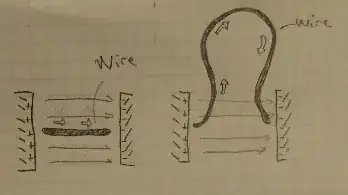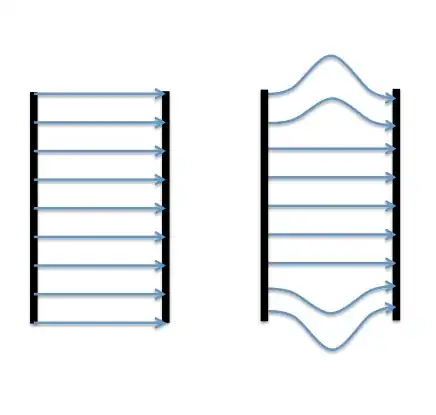When you insert a third conductor between two plates of a capacitor, you essentially create a three-plate capacitor.
The usual way to obtain the static solution (capacitors with general arrangements of the plates) to such problems is to assume the conductive materials are ideal conductors and use a numerical method such as finite elements to solve Poisson's equation for the fields in the dielectric region. Then, we obtain the charge on the surface of the conductors from the electric flux terminating on the conductor. Since we have assumed ideal conductors we know that in the static case all charge must be on the surfaces, and the field is infinitesimal (or else charge would be flowing and the solution would not be static).
If a not-straight wire is curving away (maybe into other parts of the circuit) and away from the space between the capacitors, then the charges in the wire are not inside the electric field the whole time.
Remember that the solution giving uniform E field between the capacitor plates depends on the plates being infinite in extent. So it's not possible for the wire to extend beyond the influence of the plates in this situation.
If we want to know the field distribution for non-infinite plates with a conductive material imposed between them, we again have the three-plate capacitor problem with arbitrary geometry, for which there aren't general solutions, but which we can solve numerically.
So what is moving them? There must be an electric field throughout the wire all the way, to cause a force on the charges to keep them moving, but how is it created?
If we assume an ideal conductor, it only takes an infinitesimal field to cause a large current to flow. In a real conductor there will be a nonzero field until the charges re-distribute. Once the static situation is reached, the fields produced by the surface charges will balance whatever imposed fields are present and the net field within the conductor will be zero.
Determining the fields during the initial charge flow will again probably require a numerical solution. In any real situation where this flow matters, the light speed limitation on the propagation of the fields in the dielectric is likely to be at least as important as the resistance of the material, so a full electromagnetic wave solution will probably be required.
Again, we'd solve for the electric and magnetic fields, and use the field solutions to infer the charge distribution.

